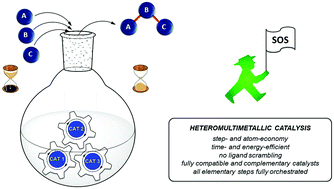Heteromultimetallic catalysis for sustainable organic syntheses
Abstract
Fully complementary bimetallic catalysis has been identified as an increasingly powerful tool for molecular transformations, which was largely inspired by early examples of sequential catalytic transformations. Thus, energy-efficient one-pot reactions involving different metal catalysts orchestrated in concert constitute an attractive alternative to multi-step protocols, with major recent progress through the elegant ligand design in heterobimetallic catalysis as well as sustainable photo-induced C–H transformations, among others. This review provides a critical assessment of the state of the art in heterobimetallic catalysis for sustainable organic syntheses (SOS), highlighting key advances and representative examples until summer 2017.



 Please wait while we load your content...
Please wait while we load your content...